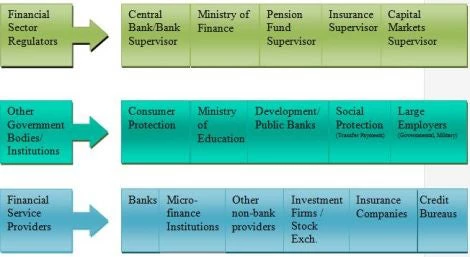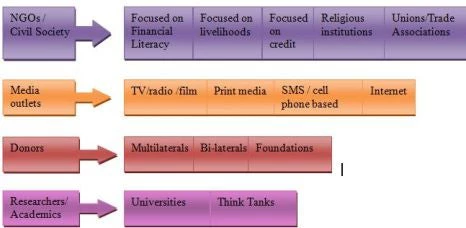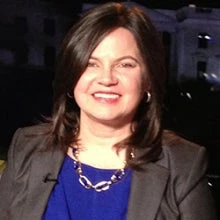This post concludes our Closing the Gap: Financial Inclusion blog series, which shares the views of selected experts and practitioners on different financial inclusion topics.
The field of financial literacy and capability has many open questions in terms of priorities, what the most effective interventions are and even basic measurement data and evidence of impact. However, one aspect of this topic where there is growing consensus relates to the importance of multi-stakeholder partnerships that leverage both public and private sector actors, as well as civil society.
As in any significant endeavor that attempts to change or reinforce consumer behaviors (encouraging savings, promoting prompt repayment of loans, taking steps to mitigate risk such as diversification of assets or buying insurance) communicating through multiple channels and partners can strengthen the effectiveness of the message. Figure 1 below shows the many types of stakeholders that may be involved in the development of financial literacy and capability programs and policies. These span the gamut from central banks and ministries of finance to commercial banks, microfinance institutions and other providers, schools, religious institutions and media firms.
Partnerships at work for financial literacy: Country Examples
In Brazil, the groundwork for a multi-agency partnership on financial education was laid in 2006 with the formation of the Supervisory and Regulatory Committee of Financial Systems, Capital Markets, Private Insurance and Social Welfare, known by its much easier to remember acronym, COREMEC. In 2007, financial education became one of the early topics the group addressed in a joint manner, through the creation of a financial education working group. Immediately, the group sought to bring in other members of government and society to address this issue including education officials at the state and government level and private providers including some of the leading commercial banks and the stock market exchange. In December 2010, this partnership became formally recognized as the National Committee for Financial Education (CONEF). It has fostered public-private partnerships to help fund the cost of financial education. For example, the nationwide survey on financial education to assess the population’s needs was sponsored in part by the Sao Paulo Stock Exchange. The development of a personal finance curriculum for the schools was funded by another private partner, the Unibanco Institute. The main website for financial education was sponsored by the bank association FEBREBAN.
In Kenya, the Financial Sector Deepening (FSD) program has played a central role in developing a strategy for the advancement of financial capability in support of the financial pillar of Kenya’s Vision 2030 development plan. Kenya’s FSD also works to advance financial capability through its role as the Secretariat for the Financial Education and Consumer Protection Partnership – FEPP. This taskforce, established in 2007, now includes more than 70 public and private sector partners including banks, microfinance institutions, media firms and non-profits. It was established by the Kenyan Government with a mandate to increase the level of financial education in the population. FEPP is charged with not only cultivating and promoting a vision for financial education within the country but also to research various tools for this purpose and to market the solutions to various stakeholders. FEPP has encouraged investments in financial literacy programs such as comics and school-based financial education as well as organized and supported outreach events to raise awareness of this issue in society.
Other countries that have formalized multi-stakeholder partnerships for financial literacy and capability include Uganda which established the Financial Literacy Foundation in 2008 to bring together public and private sectors to tackle this issue and developed countries such as the United States, which has the President’s Advisory Council on Financial Capability and Canada, with its Task Force on Financial Literacy.
Going forward, finding ways to create and foster multi-stakeholder dialogues and partnerships, especially in countries that are just beginning to address financial literacy and capability, is important. A multi-sectoral approach should help establish more sustainable and impactful approaches to financial literacy, which is being increasingly recognized as a pillar of financial stability.




Join the Conversation